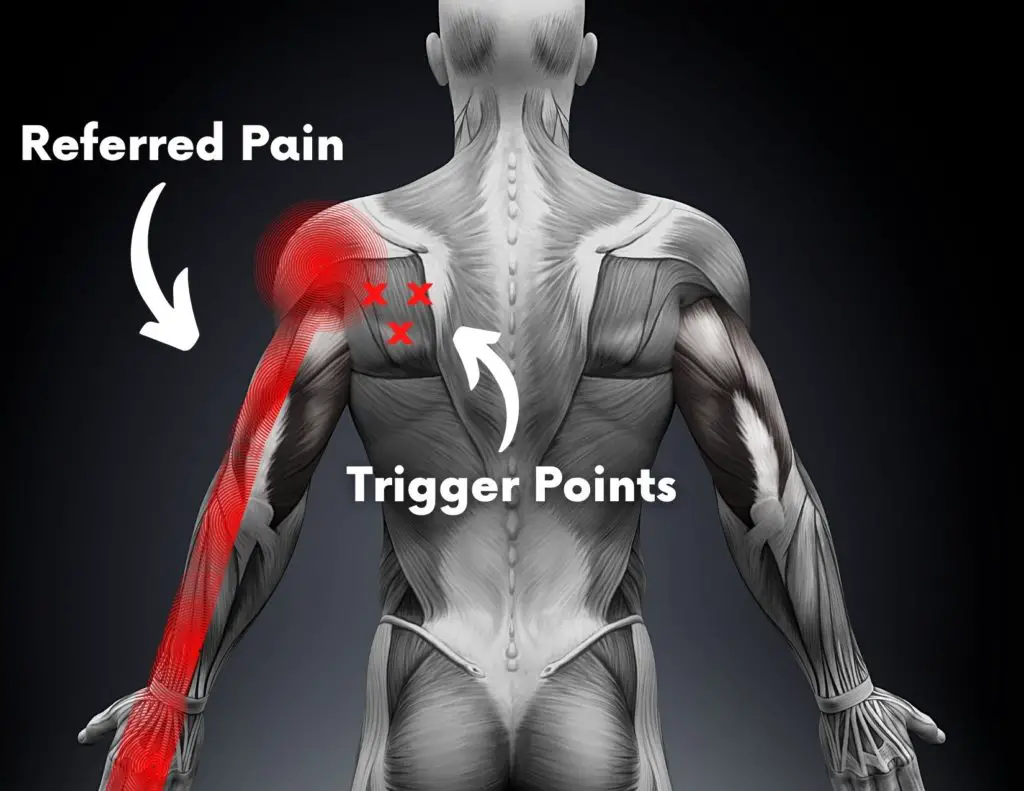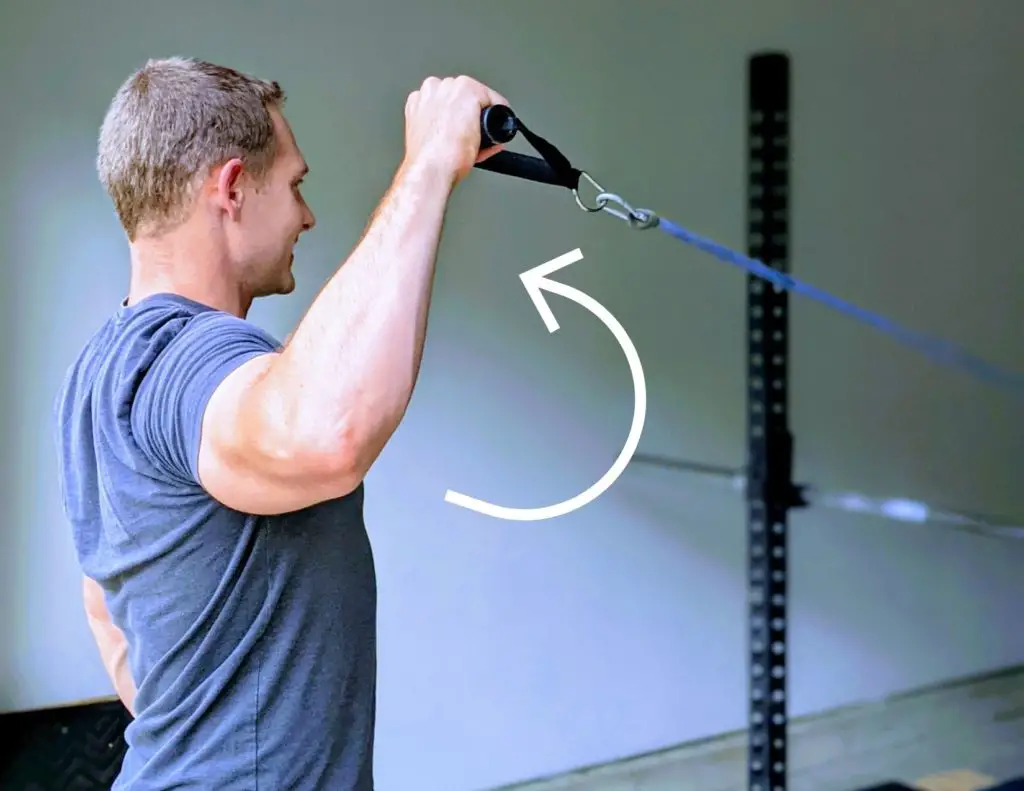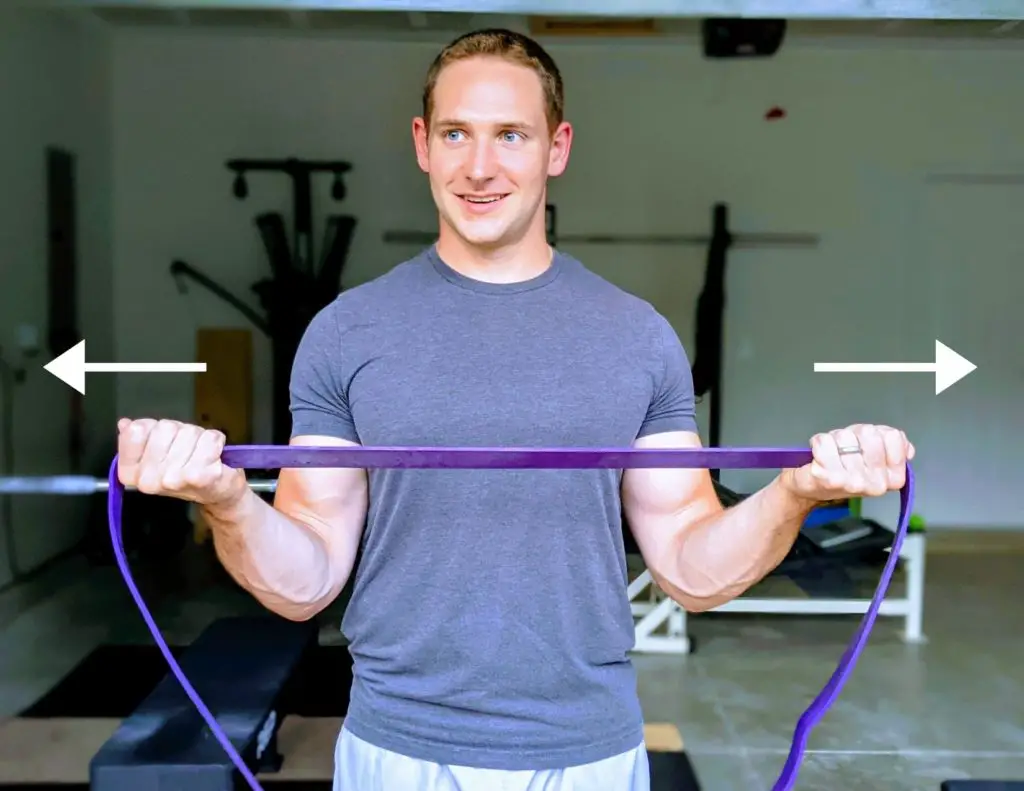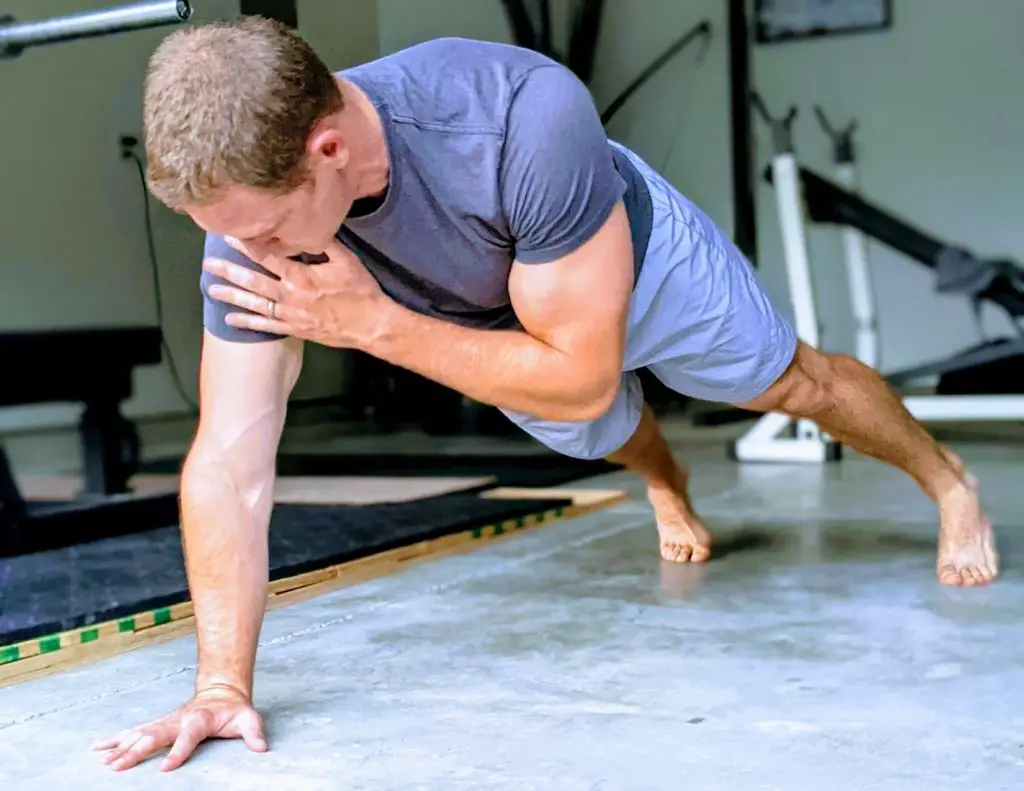A strong infraspinatus muscle fortifies the shoulder against injury. For long-term shoulder health, it’s crucial to build sturdy rotator cuff muscles to ward off pain.

In this article you’ll learn how to relieve infraspinatus pain and strengthen the infraspinatus muscle. Plus, we’ll cover the anatomy and function of this key shoulder muscle.
Anatomy
The infraspinatus is a thick triangular muscle in the upper back. It originates from the back of the shoulder blade (scapula) and attaches to the back of the upper arm (humerus).

The suprascapular nerve (C5, C6) powers the infraspinatus muscle. Suprascapular nerve damage causes shoulder weakness and muscle loss (atrophy). Severe atrophy creates a crater on the shoulder blade!
The infraspinatus externally rotates and stabilizes the shoulder.

It’s part of the rotator cuff, a key group of muscles surrounding the shoulder. The rotator cuff is composed of 4 muscles – the infraspinatus, teres minor, supraspinatus, and subscapularis.

These muscles create dynamic stability at the glenohumeral joint. The glenohumeral joint is where the humeral head meets the glenoid fossa, part of the scapula. It’s a ball-and-socket joint. It’s like a golf ball sitting on a tee – big ball, small socket.

The shoulder joint structure creates superb mobility – the shoulder is the most mobile joint in the body! But there’s a trade-off. Excellent mobility translates to poor stability.
Fortunately, the shoulder has built-in support. The rotator cuff muscles provide dynamic shoulder stability, compressing the glenohumeral joint to hold the golf ball on the tee.
Without a sturdy infraspinatus, the rotator cuff won’t function properly. Infraspinatus weakness contributes to rotator cuff injury, subacromial impingement, and other shoulder injuries.
The infraspinatus muscle itself can cause shoulder pain. Tight spots in this muscle, called trigger points, cause anterior shoulder pain and referred pain down the arm.
Many people with tennis elbow or golfer’s elbow find relief with trigger point treatments for the infraspinatus. The infraspinatus even causes carpal tunnel symptoms in the hand! (1)

True carpal tunnel syndrome originates from median nerve compression at the wrist. However, a pinched nerve in the neck or infraspinatus trigger points can also cause carpal tunnel symptoms.
Consult with an orthopedic physician or a skilled physical therapist if you suffer from hand pain, numbness, or tingling.
The infraspinatus muscle is my favorite muscle to dry needle. Patients can experience near-miraculous pain relief for anterior or posterior shoulder pain, elbow pain, wrist pain and hand pain.
Plus, it’s an easy muscle to dry needle (for a skilled professional–DO NOT DRY NEEDLE YOURSELF!!) because of its location on the shoulder blade. The infraspinatus is the first muscle I learned to treat during dry needling certification training.
Now that we’ve covered the infraspinatus’ anatomy and function, let’s get into the best exercises for pain relief and building for infraspinatus strength.
8 Infraspinatus Exercises
The first two exercises relieve infraspinatus pain. Dry needling, manual therapy, and soft tissue mobilization reduce local and referred pain from infraspinatus trigger points.
1) Infraspinatus Release
Not sold on dry needling yet? Grab a myofascial release lacrosse ball to work out those trigger points in your infraspinatus (or try a tennis ball for extra sensitive spots).
Position the ball between your infraspinatus and a sturdy wall. Hold pressure on infraspinatus, preferably the sorest spot. Bonus points if this technique sends pain down your arm – referred pain means you’ve landed on a giant, juicy knot (known to anatomy nerds as an active trigger point).

Many of my clients love this exercise. It “hurts so good” and lets them control their symptoms.
2) Infraspinatus Mobilization with Movement
Did you love the Infraspinatus Release (#1)? Here’s the more intense version!
The setup is the same. Amplify the exercise by moving your shoulder into internal rotation and external rotation.

Shoulder rotation lengthens and shortens the infraspinatus muscle under the massage ball, accentuating the mobilization. Working into mild to moderate discomfort produces the best results. It should not feel like an obscure form of medieval torture!
Infraspinatus Strengthening Exercises
These rotator cuff exercises specifically target the infraspinatus to relieve pain and prevent injury. Other benefits include enhanced rotator cuff function and shoulder stability.
3) External Rotation Isometrics
Isometric exercises activate the muscles without moving. For example, planks are an example of an isometric exercise – the abdominal muscles tighten but the trunk is stationary.
Isometrics are ideal for irritable muscles that can’t handle dynamic exercise. Plus, isometrics provide short-term pain relief for tendon pain (2), often a factor in rotator cuff issues.

To perform this exercise, gently press into the wall or doorframe. Use a towel for padding. Hold for a few seconds, then relax. Start with light effort to avoid pain and keep your wall intact.
4) Side-Lying External Rotation
Research (3) suggests this is the best infraspinatus strength exercise. Plus, it’s easy to progress. Progressive overload, gradually increasing repetitions and weight over time, is a proven way to build strength.
Lie on your side with the elbow at 90 degrees. Rest your hand on your stomach, then slowly rotate your upper arm to raise the weight skyward. Slowly return to the starting position. Repeat as desired.

Use a towel under the armpit to increase blood flow (4) and muscle activation (5) of the rotator cuff. The infraspinatus stabilizes the shoulder during repetitive tasks. Therefore, I prescribe patients high repetitions with this exercise, around 15-30 reps.
Need small weights for this exercise? Grab some here:

5) 90-90 Band External Rotation
This external rotation exercise is clutch for overhead athletes – baseball players, swimmers, volleyball players, basketball players, and tennis players.
Overhead shoulder stability boosts athletic performance and slashes injury risk. Strengthening the shoulder external rotators (the infraspinatus, teres minor and posterior deltoid muscles) is a must for overhead athletes (6).

Grab a resistance band for this one. Find the 90-90 position (shoulder and elbow bent to 90 degrees) and slowly externally rotate the shoulder, pulling the hand up and back. Keep the upper arm fixed, rotating around it as you pull against the band.
6) 90-90 Prone External Rotation
This exercise forces the infraspinatus and teres minor muscles to work harder than The Rock on chest day (7).
It’s similar to the previous exercise, except you use a light weight instead of a resistance band. Lay flat on your stomach, find the 90-90 shoulder position, and rotate around the upper arm.

7) Bilateral Shoulder External Rotation
This exercise strengthens the rhomboids and trapezius muscles in the upper back, in addition to the infraspinatus and teres minor. (But not the latissumus dorsi – the lats internally rotate the shoulder)

Keep the elbows pinned to the side and bent to 90 degrees as you pull outward on the resistance band. Squeeze the shoulder blades together, too.
8) High Plank Shoulder Taps
Closed kinetic chain (CKC) exercises, like this one, build shoulder strength and stability by bearing weight through the arm. CKC simply means the arm is fixed to the ground (think of a push up or plank). With open kinetic chain exercise, the arm moves through space, like with a biceps curl.
Both types of exercise are valuable. Closed kinetic chain strength makes daily activities easier – like pushing open a heavy door or holding a vending machine upright to avoid being crushed.

This CKC exercise challenges the rotator cuff and scapular stabilizers to control shoulder position. (But it won’t counteract an egregious sock tan!)

The start position is the same as the top of a push up. From here, slowly lift one hand and tap the opposite shoulder. Alternate arms, touching each shoulder 10-15 times.
Not only will your shoulder stabilizers get a workout, you’ll feel the burn in your abdominals and obliques as well!
Final Thoughts
A well-functioning infraspinatus is crucial for shoulder health. Trigger points and weakness can lead to shoulder pain, rotator cuff tears, elbow pain, and carpal tunnel symptoms. Not to mention disrupted sleep and worse athletic performance.
The good news is that the infraspinatus is simple to strengthen and responds well to soft tissue treatments like manual therapy and dry needling.
If you’re suffering from persistent shoulder pain, go to physical therapy or see a sports medicine physician. Shoulder surgery isn’t the only route to pain relief, and conservative treatment is often the best option for rotator cuff injuries (8).
For more shoulder strength exercises, check out 11 shoulder impingement exercises for more tips to beef up your shoulders.
For more evidence-based insights you won’t find anywhere else, join the free, fast-growing Facts & Physio Newsletter. Plus, get The Recovery Checklist when you sign up.


2 thoughts on “8 Infraspinatus Exercises to Build a Strong Rotator Cuff”
learnt a lot from this website, i was in Steel work and for a limited time did a tonne of over head drilling, pretty sure i tore part of the infraspinatus, 23 years on i have noticeable front, medial and rear deltoid shrinkage, and that small dip in the muscle where the infraspinatus lies, believe it or not i could not find a physio that could diagnose me correctly, i always feel a massive tightness in my upper trap that sort of over compensates by lifting for my shoulder and felt my shoulder was over time falling forward in a way.
so just started these exercises you have described, already feel a noticeable difference in my shoulder being pulled back down into place, it’s fighting the over compensating trap, i”ll let you know if there is some positive news in a month
David, thanks for sharing your experience. The upper trap tightness and shoulder hiking you describe are common compensations for people with shoulder issues. Sometimes infraspinatus or supraspinatus weakness or injury. Wishing you the best!